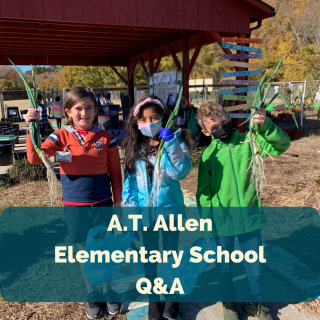
Q: What is the history of the garden at A.T. Allen Elementary School?
A: Mrs. Janet Childress was hired as a tech instructor at the school in 2014. During this time, the science teacher had a garden but it was not active. The principal, at the time, saw so much potential in the garden and envisioned a space dedicated to outdoor learning. Following this vision, a STEM program utilizing the garden was created with the help of the next principal and NC State Plants for Human Health Institute. One large garden was built with 132 beds that were accessible to all students and where students would have complete autonomy.
Q: How many students are involved with the garden at A.T. Allen Elementary School?
A: Each grade level (Kindergarten - Fifth grade) has a different themed BOB bed based on an anchor text that is linked to social studies, science, and math standards. The themed beds are as followed:
- Kindergarten - Rainbow salad
- First grade - Stone soup (with the goal of harvesting their own canned soup)
- Second grade - Tops and bottoms plus a butterfly garden
- Third grade - Studying about Doctor George Washington Carver and soil testing
- Fourth grade - Smoothie garden
- Fifth grade - Herbs and salsa which demonstrate how different plants and herbs are beneficial to our bodies
The produce from the BOB beds is used in taste tests. Students can also participate in their ‘Share a Square’ bed. With these beds, students have the autonomy to grow what they want and take home what they grow. The ‘Share a Square’ beds allow students to see the whole plant cycle – from seed to seed.
Q: What activities are done in the garden?
A: Play money was given to students for weeding the garden. With this money, they were allowed to buy any seeds they wanted to plant and research in the ‘Share a Square’ bed with their partner. Students were so excited to participate that they were coming into the garden during their recess.
Currently, four classes are piloting a composting program where they are diverting waste from the cafeteria to the garden. There are two 20 gallon trash cans located in the garden – one trash can is used for green waste and the other for brown waste. Hopefully, with this program, 100% of the compost used in the garden will be created from waste at the school.
Q: How has the pandemic affected your garden program?
A: It was difficult because there was limited in-person instruction, so students were not able to maintain the garden. During the pandemic, students also forgot how to respect the garden space. Now students are divided up into teams that help maintain the garden (cleaning, composting, weeding, etc.). The fifth graders also became more hands-on a started a mentoring program with the kindergarten students to show them how to properly take care of the garden.